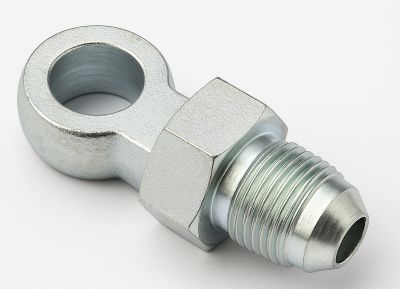Hydraulic systems power everything from farm tractors and excavators to CNC machines and marine steering gear. Inside every one of those systems, pressurised fluid must travel through hoses and tubing without a single leak; otherwise, performance drops, components overheat, and safety is compromised. That’s why adapters are so important: they let you join two different fitting styles or thread standards securely, so every drop of hydraulic oil gets exactly where it needs to go.
One of the most common mix-and-match challenges technicians face is connecting metric banjo fittings (popular on European equipment and compact machinery) to the JIC flare fittings widely used on North American-spec hoses. A purpose-built Metric Banjo to JIC adapter eliminates that headache in seconds—no re-hosing, no risky “close-enough” solutions, just a rock-solid, pressure-rated connection.
What Is a Metric Banjo to JIC Adapter?
Banjo fittings in hydraulic systems
A banjo consists of a hollow, circular “eye” that slips over a specialised banjo bolt. Fluid enters through the eye and exits through radial holes drilled in the bolt body. Because the eye can rotate around the bolt, banjos excel in tight spaces where a traditional straight or 90-degree fitting simply won’t line up.
JIC (Joint Industry Council) fittings
JIC, sometimes called 37-degree flare fittings—use a male taper and a matching female seat to create a metal-to-metal seal that’s good for working pressures up to 10 000 psi (≈ 690 bar) in many sizes. They’re ubiquitous on hydraulic hose assemblies in North America and in global mobile equipment markets.
A Metric Banjo to JIC adapter marries these two worlds. On one side, it has the metric banjo eye sized for an M10, M12, or M14 banjo bolt; on the other, it features a male JIC flare (typically 3/8-inch or 1/2-inch). Fluid transfers seamlessly through the adapter body, letting you run a banjo connection on the component port and a JIC hose on the line side, all without thread converters, Teflon tape, or worries about misalignment.
Key Features and Benefits
|
Feature |
Why It Matters |
|
Versatile compatibility |
One part lets you connect a metric banjo bolt to any standard JIC hose end—ideal for mixed-brand fleets or imported machinery. |
|
Leak-proof design |
Precision machining and a fully formed flare face deliver a bubble-tight seal at high pressure. |
|
Corrosion resistance |
Zinc-nickel plating or full 316 SS construction shrugs off road salt, fertiliser solutions, and marine spray. |
|
Compact structure |
The banjo eye sits flush against the component block, saving precious clearance inside engine bays or hydraulic manifolds. |
|
Fast, tool-friendly installation |
Standard metric socket or combination spanners fit the banjo bolt; a single JIC wrench finishes the hose side—no special crimping or sealants required. |
Common Applications
➡️ Hydraulic braking systems – Cars, motorcycles, and light trucks often use banjo bolts at callipers or master cylinders, while aftermarket brake lines may be JIC-terminated.
➡️ Industrial machinery – Press brakes, injection moulders, and automated assembly lines that combine EU-sourced hydraulic valves with JIC-ended hose kits.
➡️ Agricultural hydraulics – Tractors and harvesters built for global markets frequently blend ISO and SAE components.
➡️ Marine steering and power-trim systems – Space constraints and saltwater exposure make compact, corrosion-resistant adapters essential.
➡️ Construction and heavy-duty vehicles – Excavators, skid steers, and cranes often require last-minute hose repairs in the field; a universal adapter keeps downtime to a minimum.
Material and Sizing Options
Materials:
➡️ Stainless steel (316) – Best for saltwater, food-grade, or corrosive chemical service.
➡️ Carbon steel with zinc-nickel plating – Cost-effective choice for general industrial and mobile hydraulic use.
➡️ Brass – Suitable for low-pressure or non-ferrous systems where magnetic corrosion must be avoided.
Thread and flare combinations:
➡️ Metric banjo eye IDs: M10, M12, M14 (others available on request)
➡️ JIC male sizes: 3/8-inch (-06) and 1/2-inch (-08) are most common; adapters up to -12 can be supplied for high-flow circuits.
Installation Tips and Best Practices
1. Cleanliness is critical – Flush the hose ends and wipe mating surfaces with lint-free cloths to keep debris out of the hydraulic circuit.
2. Correct torque – Overtightening can crush the flare or distort the banjo eye. Follow the torque chart supplied by the adapter manufacturer (e.g., 12 mm banjo bolts often specify 25–30 N·m).
3. Verify seal integrity – After pressurising, inspect for weeping around the flare seat and banjo washers; a quick wipe with a clean rag will reveal any leaks.
4. Routine inspection – Check fittings during scheduled maintenance for signs of corrosion or mechanical damage and re-torque if necessary.
How to Choose the Right Adapter
1. Match pressure & flow requirements – Verify the adapter’s rated working pressure exceeds the system’s maximum operating pressure (plus a safety margin).
2. Confirm thread types and sizes – Double-check both the banjo bolt diameter/pitch and the JIC dash size —don’t rely on “eyeballing” threads.
3. Consider the environment – High-salinity, acidic, or high-temperature applications may require stainless or special coatings.
4. Check certifications – Look for ISO 8434, SAE J514, or equivalent compliance, and request material test reports (MTRs) for critical installations.
Conclusion
A Metric Banjo to JIC adapter is a small part that solves a big problem: uniting two globally dominant fitting standards without compromise. By choosing a leak-proof, corrosion-resistant adapter that’s correctly sized for your system, you’ll enjoy:
➡️ Faster repairs and retrofits
➡️ Fewer leaks and callbacks
➡️ Longer hose life and lower inventory costs
In short, the right adapter keeps hydraulic circuits safe, reliable, and efficient—so pumps, cylinders, and motors can do their job 24/7.
Looking for a dependable Metric Banjo to JIC Adapter? Contact our engineering team for a fast quote or browse our
Post time: Jul-29-2025


